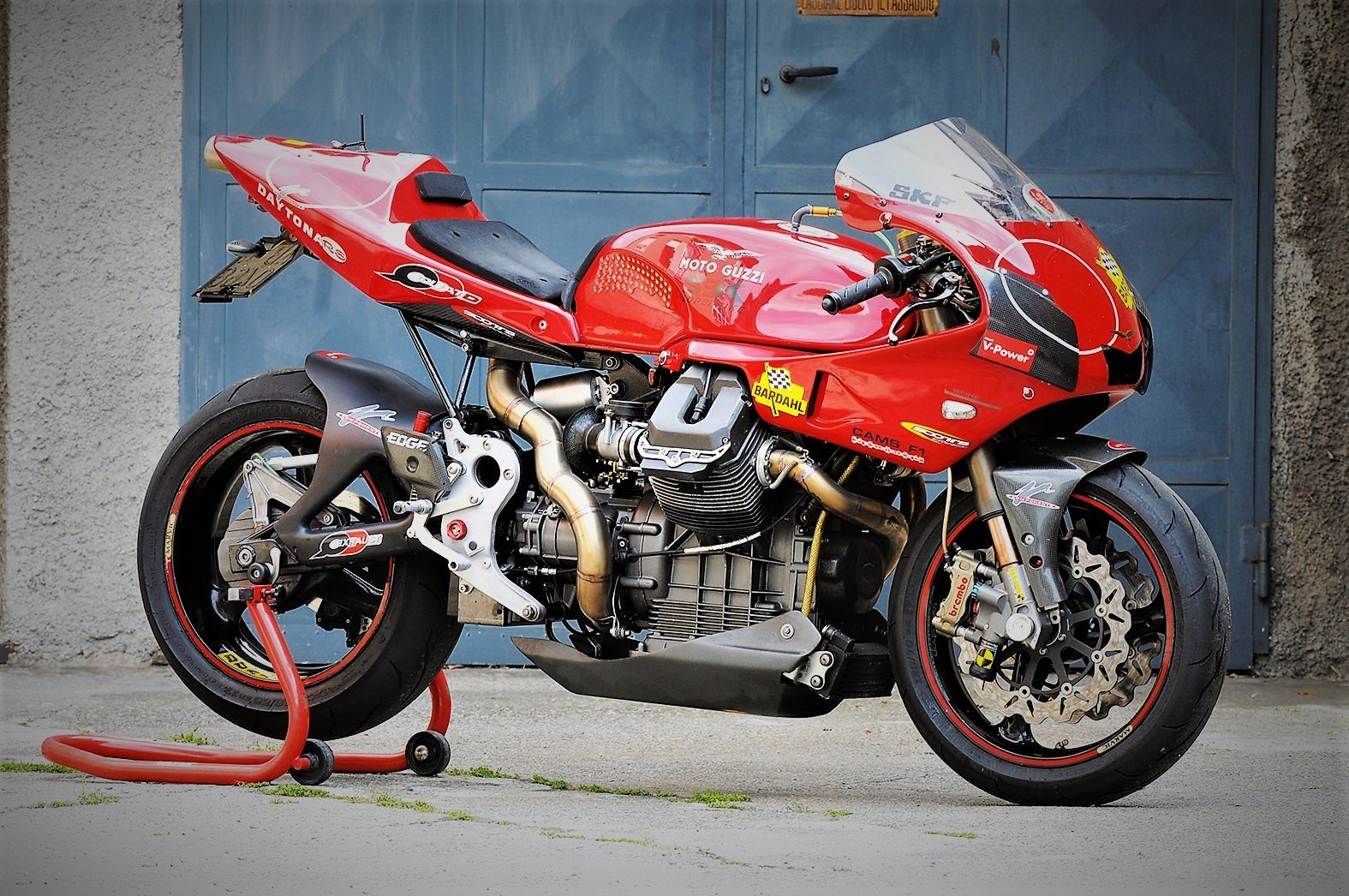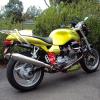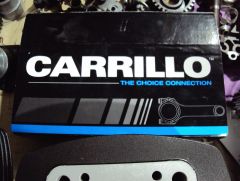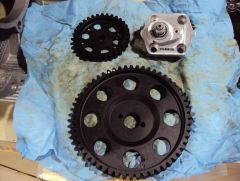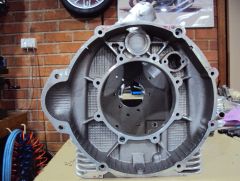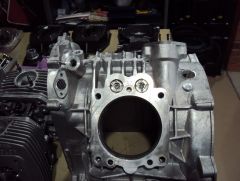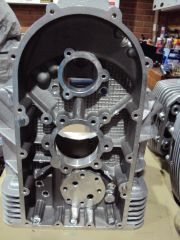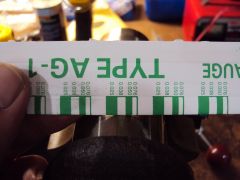-
Posts
5,215 -
Joined
-
Last visited
-
Days Won
268
Content Type
Profiles
Forums
Events
Gallery
Community Map
Everything posted by Lucky Phil
-
It’s possible but it would take someone very skilled so it doesn’t distort. Fortunately the barrels aren’t rare. A brand new barrel is $900. Brand new. I have a couple spares, with broken fins. Fins are cosmetic so easy to weld up. Sent from my iPhone using Tapatalk It just made me think of the great John Britten. He had a crack in the sleeve at Daytona, right after qualification. He tore it down, welded it with a borrowed torch and a coat hanger, and raced the next day. Still amazes me. What used to amaze me with the Britten guys is that they travel across the world to a track thats just about all WOT without any engine spares.They were the same when they used to come to Australia, was basically a bunch of guys working out of the boot of a car. Got to love Kiwis, very resourceful people. Makes me wonder how successful they would have been if they were halfway organised. Ciao
-
I have no doubt there are people that would:) Nice Video Dave. Quietly going about the task in the workshop with friends is always enjoyable and you have the comfort of knowing you are following the exact same footsteps of many a Norton Commando owner:) Ciao
-
I doubt that this is the only reason, but certainly a contributing factor. The ADC used in the 15M is a 8bit, which resolves the 5V to steps of 19,53mV. The delta between 157 and 170mV is 13mV, this equals roughly one ADC step. So the fuel values would slip one row, which is noticeable but not to the extent of what you describe. A re-sync is what I would do. Cheers Meinolf Here's one for you Meinolf. When I fit my Daytona engine to the V11, what throttle bodies should I use? I have the original sideflow green injector bodies from the Daytona with the old large style TPS and a set of the V11 throttle bodies with the older style injectors and the smaller TPS. I'd prefer to use the side flow injectors because they make the plumbing neater but will the 15M ecu accommodate the old style TPS? My next decision as well is whether or not to use the 15M and Guzzidiag or the Myecu that I have on the shelf. Any thoughts on these combinations? Can I source a Daytona fuel and ignition maps for the 15M? Looking for the simplest and easiest way out with the least research involved. Forgive me for being lazy. Ciao
-
Ok Chuck thanks. Seems to tally from my flying around days with the 737-800's and them having around 25% of Sea Level thrust at 40,000 feet. Climb and accell was fairly leisurely at those altitudes as was engine response to the thrust levers. Ciao
-
I've been thinking about this for a while before responding. Elevation equals reduced cylinder pressure, no exceptions. So that cannot be the source of your ping. I can say with certainty that the variability in pump gas out west was disconcerting and surprising. My 1100 Sport-i was sensitive to gas stops far more that it was to altitude. I never got pinging, but I did get noticeable weakness and a couple times generally unhappy low-throttle running. I don't believe for a second that either the octane number nor the alcohol listed on the pumps is a reliable indicator of what's going in the tank. Miles per gallon was the most noticeable difference, however. It varied between 45-ish in Georgia to 34-ish in New Mexico, though the performance aspect is not so apparent on those long flat fast stretches. NoCal and Washington State seemed the least consistent. Of course, none of this is scientific, only subjective- but over 10k miles one gets a good feel for what's going on. So I'll suggest that your condition is a symptom of local fuel quality. The worst tank I had by far was somewhere South of Sacramento. Not quite. Pre ignition or ping as well call it here is caused by hot spots in the combustion chamber that cause the fuel in isolated areas to, well pre ignite hence the sound you hear. Detonation is caused by the fuels inability to maintain its chemical stability during the ignition event and the oncoming flame front and then burns in an uncontrollable fashion combined with the spark ignited flame front and the two intersecting a lot more cylinder temp and pressure is created. A much worse scenario than ping. The reasons for both are many and varied. But back to the original issue.Poor fuel can of course cause ping but the altitude can also play a roll if not be the actual cause. When you climb 3000 feet the pressure will drop 3/4 of a psi. (old aircraft engineers figure-1/4 psi per 1000 ft) Chuck may be able to confirm piloting and all. So thats about a 5% drop in atmospheric. The ecu of course leans out the mixture to compensate and of course you get a commensurate drop in power. Problem is your brain and right wrist dont necessarily accommodate this loss of power and unconsciously just apply more throttle to achieve the same performance. So what you end up with is the same load ( speed and resistance to climb the given rise) but with a leaner mixture and more throttle and if the temperature is also high more leaning.Result....increased combustion chamber temperature, hot spots and ping. Your theory about elevation and cylinder pressure also only holds true for WOT or a given throttle position. But in the real world when we all ride the reduced atmospheric pressure is compensated for by opening the throttle more to maintain the performance we seek. Most of us even when we are "going for it" in the twisties are only using maybe 35-50% throttle. You'd be amazed how little time even a race bike spends at WOT. Ciao
-
This whole modernist phenomenon of "motorcycles as art" or "sculpture" thing kind of offends me. It would if it was "airplanes as art" as well.The real talent is to design and build something beautiful and what could be described as a work of art whilst making it dynamically superior. Form and function in perfect harmony at a high level. Old dungers with cut off guards and polished bits with magnetos hanging out in the breeze and a look of obvious and total unrideability is just a vacuous wast of time for mine. Ciao
-
There are no nuts on Carrillo rods the bolts thread into the rods. There would also be no need to replace rod nuts after torquing as the nuts arent subject to any stretch. As a matter of fact if you use ARP head studs ARP suggest you torque the heads twice on installation to run in the threads on the nut and stud. This gives greater clamping consistency. The say their research shows torquing the studs around 8 times runs in the threads on the nut and stud to give the best results as far as torquing consistency goes. Ciao
-
No the Carrillo SPS bolts are reusable anyway as long as they haven't been over stretched.I also didn't torque them up to full spec, held it about 15% less than final torque. If you use brand new bolts what you can do is measure the free length of the bolts then torque the bolts up to a little under full spec and then measure the bolt free length when you pull it apart again. If the bolt hasnt stretched then its good to reuse. Going the last 10 or 15% of the torque isnt going the change the clearance reading unless you have rubbish rods that distort the cap. Once the rod cap faces have seated and applied the crush to the bearing then with a good rod the clearance figure wont change appreciably, the rest is just applying stretch to the bolt to allow it to take the running load and stop it undoing. Ciao
-
I dont know what the mileage actually was which makes it hard to evaluate the longevity of components and where to focus on improving. I know what I was told it was by the seller that operates out of the states and we all would know but I cant seriously believe that figure after receiving the engine.The same as I cant seriously believe that it was a strong and healthy runner at the time it was parted out. To say I was disappointed at its condition when I received it would be an understatement. Wont be dealing with him again I can assure you. What I do know about these engines after 7 years of research and owning 3 pairs of heads off different engines is that the main issue with them is the top end. Valve guides wear badly as do lifters, rocker bushes and to some extent valve seats. Cams seem fine. The valve guide issue can be eliminated by using micropolished gas nitrided valves instead of the stainless versions. The bottom end has issues with the aluminium cam drive gear and oil pump drive gear and the oil pump running no bushing or bearing. The cam gears and oil pump gear in my engine were worn badly enough to replace but paradoxically the oil pump was fine. A little worn but usable. The heads on my engine had very bad guide wear (by that I mean 0.030" actual stem to guide clearance) and one head had 2 completely toasted exhaust valve seats, all four rocker arm bushes and pins were worn out and all the lifters were toast. Cams were ok. If my engine had a genuine 100,000 miles on it I would be ok with that level of wear but if it had 40 or 50,000 miles then I would be horrified. In general the std Daytona engine has a reputation as being a little fragile and wear prone and I would probably agree with that. Once the cam and oil pump drive gears and the oil pump are addressed then the bottom end is bullet proof. New guides and the afore mentioned valves and the use of high quality oil and I think the top end issues are also largely addressed as well. Ciao
-
German DAS/DHS? oil pump and Joe Caruso steel gears. Sent the rods back to Carrillo for a refresh as well Ciao Yep good reliable setup. Joe Caruso is making oil pumps as well with the idler gear rotating on a fixed steel shaft like a Ducati pump. A better idea than all the Guzzi and even the aftermarket pumps with the idler gear shaft rotating in the pump housing. Ciao
-
Perhaps I can stop filling the neck well up into the tank and see if this improves or abates. Maybe it only occurs after a fill up and that's why it has been so sporadic. As the tank heat soaks from the engine after you park it post tank fill they will often pass some fuel out the vent docc. Try topping right up and not so full and see the difference if any with regards to "spooging" When I refitted the tank after I put in the cam gears I kinked the vent hose. First indication was after the first ride I went to park the bike and the front fork leg hit the tank to the point where I couldnt lock the steering, both sides. I fixed the vent line and the tank stopped expanding and all was good. Amazing the tank would stretch on each side at least by 1/4 inch due to the pressure and heat rising from the engine. Ciao
-
If you put your finger on the bottom of the butterfly shaft on the l/h throttle body you may also find where "spooge" is coming from. Raw fuel leaking from the shaft and dripping onto the starter cover and then the ground. Ciao
-
No failure, just heavily worn top end really. I just wanted to do a full and proper rebuild. Its generally all or nothing for me in most things, or it used to be when I was more financial. I need to be a little more pragmatic these days. All this stuff was bought before I retired. I measured up the old mains yesterday and they are totally usable but I have new ones to fit. The heads will have brand new lifters, rocker arms, guides, L/H cam, valve springs,valves and seals. The cylinders have been re nikasiled as well, new piston and rings and I have a new RAM single plate clutch assy. Its basically going to be a brand new engine. Ciao
-
German DAS/DHS? oil pump and Joe Caruso steel gears. Sent the rods back to Carrillo for a refresh as well Ciao
-
I think earlier in this thread they said the 6 speed clutch was no longer available. You can still get them apparently. https://hmb-guzzi.de/Clutch-Internals_1 Ciao
-
Big end clearances, both the same .038 mm or maybe a fraction under, perfect. Front and rear mains were spot on at .040 both ends.Middle of the range for the front and bottom of the range for the rear. Crank end float 0.10 mm, again spot on. Also spent some time with the die grinder de burring the crankcases, don't know why I bother really, just driven to do it. A bit of Chuck therapy I think. We all get it in different ways:) Ciao
-
From the album: lucky phils V11
Big end clearances, both the same .038 mm or maybe a fraction under, perfect. Front and rear mains were spot on at .040 both ends.Middle of the range for the front and bottom of the range for the rear. Crank end float 0.10 mm, again spot on. Ciao -
WTF, there's rubber toothed belts under the front cover as well !!!! Ciao

